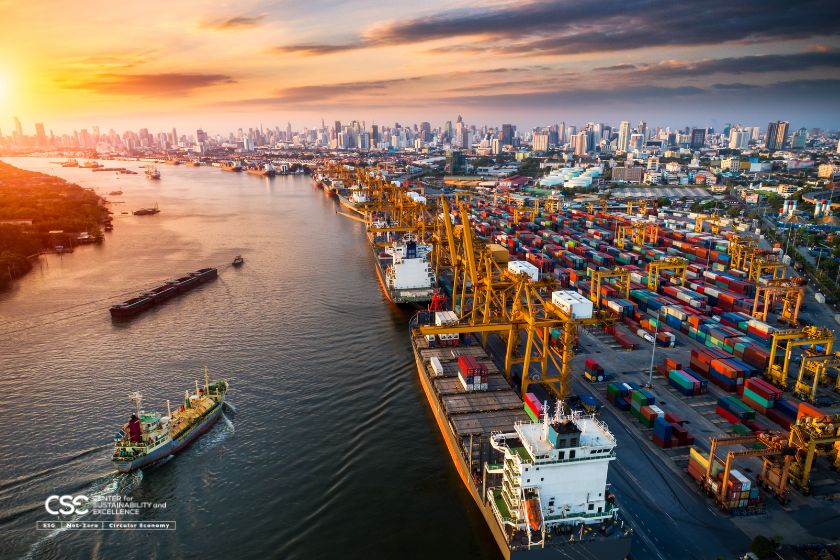The transition to a circular economy is no longer a theoretical ideal—it’s an urgent imperative. Linear supply chains, with their “take-make-dispose” model, are not sustainable in a world grappling with resource depletion, environmental degradation, and climate change.
As we navigate the circular economy, the Logistics and Shipping sectors are at the heart of enabling circularity, transforming from linear enablers of goods movement to key players in a regenerative economy.
Key Challenges for Shipping and Logistics
- Complexity of Reverse Logistics
Reverse logistics involves the return of products, components, and materials from consumers back to manufacturers or recyclers. This creates new logistical challenges, including the need for efficient collection systems, sorting, and transportation. Handling diverse product conditions, integrating multiple actors, and managing fragmented flows requires advanced planning and infrastructure. - Increased Localization
The circular economy emphasizes localized and regional transport networks over global supply chains. This shift necessitates the development of local collection centers, repair hubs, and recycling facilities. Existing logistics networks must adapt to serve these decentralized systems effectively. - Technological and Digital Integration
Logistics functions must adopt technologies like blockchain for traceability, digital twins for predictive analytics, and real-time data sharing across complex networks. Achieving seamless integration while ensuring data security and compliance is a significant challenge. - Regulatory and Policy Compliance
Evolving regulatory landscapes, such as differential treatment for recycled materials and import/export tariffs on secondary goods, add complexity. Navigating these frameworks requires strategic foresight and collaboration across industries. - Cultural and Operational Shifts
Transitioning from linear to circular models demands a cultural shift within organizations. Logistics companies must move beyond traditional transport and storage to embrace new value-added roles such as repair, refurbishment, and remanufacturing.
Key Opportunities for Shipping and Logistics
- New Revenue Streams
The circular economy opens avenues for logistics providers to offer value-added services, including component disassembly, refurbishment, and secondary market redistribution. These high-margin activities can transform logistics companies from cost centers to profit generators. - Enhanced Supply Chain Resilience
Circular supply chains, with their focus on local and recycled materials, reduce dependency on volatile global markets and geopolitically sensitive resources. This diversification boosts resilience against disruptions. - Sustainability and Carbon Reduction
By reducing reliance on primary raw materials, circular logistics minimizes environmental impact, including greenhouse gas emissions. Zero-emission transportation and optimized routing further bolster sustainability credentials. - Collaboration and Ecosystem Building
The circular economy fosters partnerships across industries, enabling shared infrastructure and resources. Collaborative logistics solutions, such as pooled transport networks, enhance efficiency and reduce costs while advancing sustainability goals. - Innovation and Job Creation
The circular model drives innovation in logistics operations, product design, and resource recovery. It also creates employment opportunities in areas such as recycling, remanufacturing, and repair.
Considerations for Sustainability and ESG Managers
Sustainability and ESG managers must prioritize transparency and accountability by implementing robust tracking systems for material flows, leveraging technologies like blockchain to ensure traceability and compliance with sustainability goals. Transparency fosters trust among stakeholders and consumers. Balancing economic and environmental goals is also crucial, as circular models, while promising cost savings, require significant initial investments in infrastructure and technology.
Managers should carefully weigh immediate economic pressures against long-term sustainability benefits. Success in circular systems hinges on collaborative engagement with stakeholders, necessitating cross-industry partnerships to align on shared goals, standardize processes, and build mutually beneficial frameworks. Additionally, investing in digital transformation is critical, as Industry 4.0 technologies—such as real-time data exchange, predictive analytics, and automation—help manage the complexity of circular supply chains.
ESG managers must also stay ahead of regulatory changes, adapting strategies to evolving policies and advocating for supportive regulations, such as tax incentives for recycled materials or penalties for waste. Lastly, driving cultural change within organizations is essential, fostering a culture of sustainability and innovation through training programs and internal communications that embed circular principles into everyday operations.
The circular economy represents a transformative opportunity for the shipping and logistics sectors to become pivotal players in a sustainable future. While challenges abound, proactive adoption of circular practices, combined with investment in technology and collaboration, can unlock unprecedented opportunities for growth, resilience, and environmental stewardship.
Sustainability and ESG Managers are uniquely positioned to lead this transition, ensuring their organizations not only survive but thrive in a circular economy. Stay ahead of evolving regulations and attend our upcoming Global | Certified Sustainability (ESG) Practitioner Program, in Shipping & Logistics, Advanced Edition 2025, on February 06-07 & 10 to get ready for the impact of ESRS, CSRD, and CS3D European Legislations on Shipping and Logistics. Gain practical strategies to achieve compliance and benefit from tailored guidance and actionable solutions to position your business at the forefront of sustainability.







